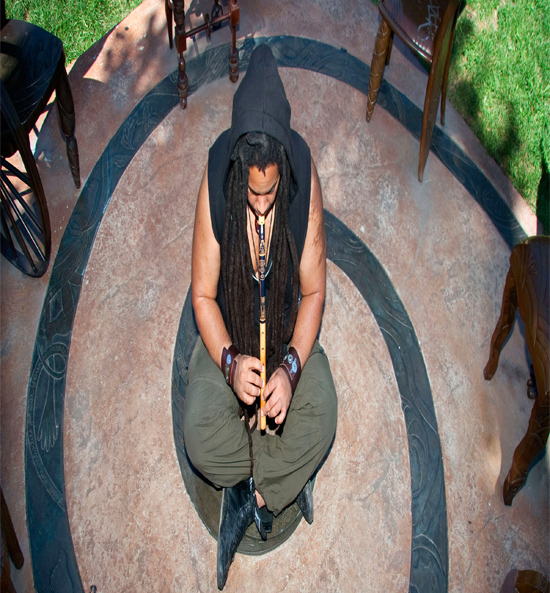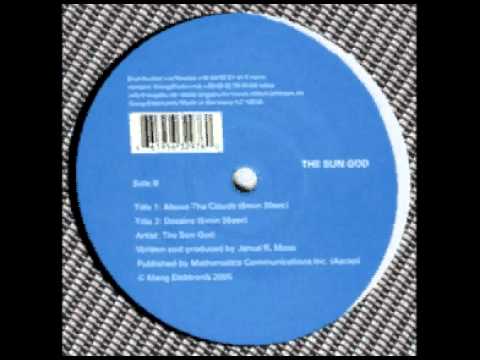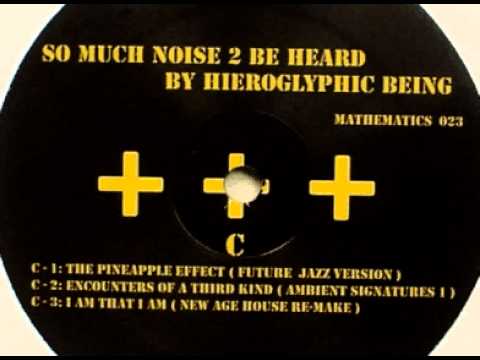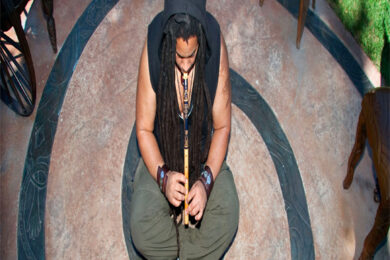Glance through a selection of Jamal Moss’ track and album titles, and you’re confronted with a complex web of allusions: Conversations In An Analog Dialect; Temple Of The Sun; The Madness of Spheres; A Visitor From Someone Else’s Memories; Rhythmes Circadiens; 2 Bath In The Black Sun; Alter Ur Destiny. Blending concepts drawn equally from hard science, New Age mysticism, science fiction and Borgesian dream logic, esoteric literature and the Afrofuturist imagery of Sun Ra and later Miles Davis, they evoke a dizzying and at times contradictory set of ideas, suggesting the blurring of lines between disciplines that generally hold one another at a suspicious arm’s length.
The same is true of his music. Rooted in the house music history of his Chicago home, it feeds equally from jazz, industrial and noise, expressing these influences in the form of long and semi-improvised jams where single motifs are repeated, layered and swirled together to the point that they swell to fill the entire mix. Tracks are abrasive, scorched by solar radiation and beset by screaming electronic interference; kickdrums are squashed to the point that their boundaries become indistinguishable from the surrounding murk; melodies can be either sweet or sinister – or both at the same time – and trace winding pathways through the fray, occasionally aligning to form intricate polyrhythmic lattices that flirt equally with harmony and dissonance.
They’re released under a similarly bewildering array of monikers. Some – his most well-known, Hieroglyphic Being and The Sun God – are direct references to Sun Ra, whom he cites as his primary influence; others – IAMTHATIAM, Africans With Mainframes, I.B.M (Insane Black Men) – conjure up similar associations as his artwork and the titles of his albums and tracks. Many are released through Moss’ own label Mathematics, also home to music by kindred spirits like John Heckle and Marcello Napoletano, as well as Chicago house veterans Adonis and Steve Poindexter, who were among those that taught and supported him in the early years of his career.
Stretching back through two decades of prolific output, Moss’ is a frankly daunting back catalogue to get to grips with. The best way to begin is probably just to dive in at any random point, though a few more recent 12"s suggest directions for further exploration: A Romance of 2 Planets‘ (Alter, 2010) joyous, semi-formless cosmic funk; the heady 14 minute house/drone of IAMTHATIAM’s meditative Time 4 Harmony In This World (Mathematics, 2011); the off-world disco and polyrhythmic house of his A Visitor From Someone Else’s Memories EP (Mathematics, 2010). He’s also about to release a new 12", The Lost Transmissions, via Morphosis’ Morphine label (which you can stream here) as well as The Human Experience EP 8 through Mathematics.
Outside of his recorded productions, whose gradually unfolding contours and blurred colours frequently feel like they’ve been cropped straight from much longer ongoing sessions of experimentation, Moss is also renowned for an equally uncompromising attitude towards DJing and live performance. His DJ sets are harsh, mutable and often downright confrontational things, at least for those raised on a diet of smooth blends and exact synchronisation: inspired by Ron Hardy’s legendary sets at Chicago’s Muzic Box and mirroring his approach to production, they’re unafraid to flip seemingly at random between tempos and genres. His beatmatching is often scattershot, causing tracks to slip in and out of time with one another as though played off 12"s left out in the sun for too long; at times he’ll intentionally drag the pitch control through a pronounced downward arc, distending tracks outward into freakish versions of themselves, bending time and scrambling his audience’s internal metronomes.
This isn’t music as relaxing throb, a slipstream to fall into and become lost; it’s hyper-stimulating and exhilaratingly tactile, forcing dancers to confront again and again, every second, the physical reality of the club situation they’re in. "Each song has its own signature, its own harmonics, its own vibration," Moss explains over Skype from his home in Chicago, "and if you’re sitting there dulling that sound when you’re blending that so smoothly, then you can’t properly transmit the energy that song is supposed to."
Live, he’s become known for his analogue drum machine and synth sessions, which find him swiftly improvising and programming beats at the last minute – often even after he’s arrived at the venue. "People probably think I’m being a total ass," he laughs, "because I’m sitting in the corner somewhere, avoiding the party or avoiding the artist that’s actually before me. That’s not the case. I’m actually sitting there reading the vibes and energies of the environment and programming beats there, then I’d go onstage and set up and then play the stuff out and actually make stuff live on the fly when I’m sitting there." Recently, however, he’s invested in some newer gear, including a laptop with a touch screen and an Akai EWI, a digital wind instrument – a set-up he’s planning to debut on his current UK and European tour. "My whole hustle now," he declares, "is basically to blow peoples’ minds and play 303 acid sounds through an Akai EWI over some beat tracks."
In advance of those shows in the UK and at Krakow’s Unsound Festival later this month, the Quietus caught up with Moss to discuss Sun Ra, Chicago, and how his music mirrors the chaotic and unpredictable nature of day-to-day life.
I’ve been aware of your music for a while and heard bits and pieces, but it’s only been in the past year or so that I’ve delved properly into your Mathematics stuff. I was aware there was a depth there, but it seemed a bit of a dauntingly huge back catalogue to know where to start.
Jamal Moss: It comes from the aspect of… Let’s put it this way, if nobody’s thinking about you, you’ve got to think of yourself. So it means you constantly keep yourself busy by working at your trade and your craft, so that’s basically what I did. I didn’t get bitter, like ‘Why’s nobody booking me?’, or ‘Why aren’t I doing shows?’ – I do this because it’s from a therapeutic standpoint and I know this is my calling. So if I’m not doing shows for months on end I’ll always be writing. And if no label wants to put out my stuff, I’ll just put it out myself. So that’s why I have so much material out there floating around – because it’s mundane to sit around and put your fate in one man’s hands. To mould your destiny, you have to do it for yourself. That’s for anyone.
You mentioned something I was interested in asking you about. Unlike a lot of electronic musicians/producers, there’s a definite sense that what you do is a craft or a discipline, it feels like you’re in a continual process of self-development. Is it something you practice at every day, this ‘craft’ aspect of what you do?
JM: Yeah. It’s kind of like if you’re doing tai chi, or working in wu shu, or a form of meditation, or if you were into yoga. This is like my form of that. So every day I sit down and work at it. It helps develop me as a person, and develops my mind and my capabilities of what I could better become. So at this point I still don’t see what I do as perfect. I’m working on perfection. Hopefully I’ll be able to do it – I might not be able to do it – [but] the whole point is I’ll just keep trying. Some people say ‘Stay hungry’. It’s not about staying hungry, it’s just never get too comfortable. That’s when you fall off.
If you were to ever achieve perfection you might then get bored. By not ever quite reaching it there’s always something else to strive towards, I imagine.
JM: Yeah. Well, in the process I try to branch off to other things, that’s [part of] working on my form of elevation – I try to help other artists who’re going through the same process and put their stuff out. So even if I finally reach that nirvana or that bliss in what I do, I still can say, ok, if I’m at this top or zenith of what I am or who I am trying to become, I can set up other people and give them a hand up in the process. So that’s why I’ve got the label – to try and help other people who need help getting their own stuff out. I put it out through Mathematics.
You say ‘this thing that you could become’. Did you ever, or do you now, have a vision for what that is?
JM: I’ve always visualised it from a young age, that’s the whole point of staying on that path and walking that direction and not steering off it – and I have, because that’s part of life, things can deter you or sway you from it – so it’s like, I have the vision, I’ve had the image of what I’m supposed to be. But a lot of the time it takes work. It’s like if you’re working on a visual art piece or a sculpture, or when you’re building something. It takes time, it takes rivets, it takes points and joints, whatever the motive to get you to where you need to be.
Some aspects of how it’s engineered can be done in a short period of time, sometimes it can be a long period of time, and sometimes it could just be eternal. I could be dead, and the stuff finally won’t mould until after I’m long gone off this planet. You have to look at some of the other artists that I aspire to, like Miles Davis, Sun Ra – their stuff is still building itself even after they’ve crossed over to the other side. They was working on perfection or working on themselves through their music, and still working basically to the point where they crossed over, but their music still evolves and still has some form of perfection that’s still being worked on, even though they’re not here. It’s still working on itself, even though they’re not around physically to keep it growing or nurturing.
Through the work of people like yourselves, who pick up those inspirations and develop them further?
JM: Exactly. I’m still building on that structure. Adding to the continuum.
What you were saying before about music being a process for yourself – from a listener’s perspective there’s a meditative aspect to a lot of your music. Do you find it quite a meditative experience to make it? Is there a sense of falling into what you’re doing while you’re making music?
JM: It’s half-and-half. Sometimes I’m actually conscious of the process while I’m into it, and then it’s later on – depending on how long I’m working on some projects – that I will go into more a meditative state or a trancelike state, and I’m just not conscious of time and space. I could get up at 8 in the morning and before I know it it’s 1 o’clock at night, and it feels like only 3 or 4 hours has passed. That’s the best way for me to describe it without embellishing super esoteric teachings or leanings to it. But sometimes, yeah, time and space just disappears when you’re really focused and honed in on your craft.
So does your working process then involve quite a lot of jamming and improvisation? Is it quite tactile, and come out the way that it does over a long period of time?
JM: It goes half and half again. Sometimes I can sit down and jam it out the way I want it to [be], and then sometimes I’ll sit down and work on something, [and] the sound will start to bleed, like if you have a collage of colours and you just mix them together. It’s like a hot mess, the colours all run together, they’re visually unappealing. It’s the same thing sonically, I can sit there messing around with my drum machines and my keyboards and I hear so many sounds and go through so many patches, ’til almost I become deaf. I don’t hear the right frequencies or oscillations or harmonies, because I’ve been messing around with stuff for so long, so sometimes I have to sit back and go do something else, then get back to it. Cleanse my sonic palette, and get it right.
You allude to the murkiness of your sound – that’s one thing that gives your music a very distinctive signature. I’m interested in what inspired you to develop that sort of approach. When I listen to your records, a lot of the time I get that feeling that you’re in a club, and sounds at high volume are blurring and bleeding together, enveloping you and turning your skin into an extension of your eardrums.
JM: I kind of came up with that when I used to go out. I partied in the Chicago scene, so a lot of stuff I heard in the beginning was dirty to me. You’ve got to realise that in the 80s, up to a certain point, everything on the radio was commercial and clean, studio tight across the board. Then all of a sudden this other sound I started hearing had more a not-so-clean aesthetic to it. I started getting exposed to industrial, EBM, jack tracks, acid house, so that was what my brain was tuned into, more than what you’d hear on popular radio, and that’s what I’ve always gravitated to since day one. So I really can’t get into the clean sound, because it’s a representation of what’s life’s supposed to be, and life’s not that clean! Life is muddy, life is dirty.
And the thing is, I never dealt with having a $100,000 studio or having fancy synth software, or tubes and amps, and the fanciest keyboards and the fanciest mastering process. For me it takes it away from its original source when you put too many layers in between the creativity.
You mentioned coming across things like jack tracks, industrial, EBM. What was your introduction to that stuff?
JM: My first introduction would be college radio stations. And then I would hear mixtapes from other people in the neighbourhood and I had relatives that was going out to parties and doing whatever. But it was an eclectic bunch of people that I grew up around, so if you were around certain people they might be into one thing, and then if you were to go two blocks over they might be into something else. The neighbourhood I grew up in was a collective of multifaceted individuals who were into different things. Everybody wasn’t a clone, everybody wasn’t identical, even though we come from the same cultural background in a black neighbourhood on the South Side. So you had somebody that was black that was all into Spirogyra, you had somebody that was black that was into – who’s the group that did The Wall?
Pink Floyd.
JM: Pink Floyd. You see what I’m saying? Then you have somebody else two blocks over that’s all about P-Funk, then somebody else who might be into classical. That’s what happens when you walk out in the neighbourhood and go to a block party or go into the playground, and you have people with their cassette players listening to music, and you say ‘Oh, what you listening to?’ You catch something that might be different from what you’re into and then you switch tapes. There’s the philosophy of the mixtapes of the 80s, people pass them around back and forth to connect with each other.
But for me to get more into the EBM and industrial thing, it moved forward with the college radio stations, because they’re the youth and they’re not part of the mainstream industry. So you would have KKC or HPK that would play some stuff, and then they would promote some parties that people of a certain age could go to, so I would travel to other parts of the city where people were of different ethnic backgrounds, so you would get exposed to more the EBM, industrial or synth pop. And in the process, with kids coming from the inner city or the predominantly black areas of Chicago, and they go to the North Side of Chicago or the suburbs, they’re bringing mixtapes with them of what influences them. That’s how I got influenced – heading up North Side and the suburbs, and got exposed to a whole plethora of musical tastes.
And then you were drawn into the early jack tracks and acid house from that.
JM: Yeah.
There is that connection – the rawness and the immediacy, the sense that something’s being laid down in real time.
JM: ‘Cos it’s more primal just to try and do it in one take and get it out the way, if you have an actual schematic of how you want it already blueprinted out. Compared to – you write, you make it, you sequence it, you do it how people do it now, lay it down and do all the filters on each channel – to me it takes away that energy when you do that. You’re squashing that energy. And for me I have a short attention span, so I can’t sit there for five hours working and tuning each channel, each sound, to make sure it works a certain way. I might spend a couple of hours messing with sounds to create the track and then do it in real time, and be done with it – I can finish a track in 8, 10 minutes. But when it comes to the opposite, nah, it’s not in me. Because I’d just go bonkers and jump out the window if I had to do that.
It’s like those people who can spend 8 hours tweaking a hi-hat.
JM: Exactly. I can’t do that.
Feature continues below image
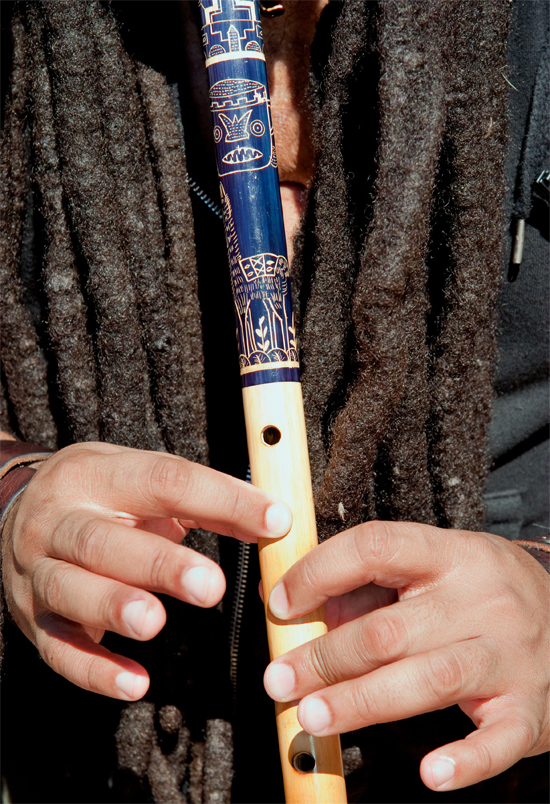
I can feel a great volume of ideas and references in your titles. Something in particular that struck a chord with me was the reference to Borges, who I’m a great fan of, in the title of Le Jardin Des Chemins Bifurquants. Is literature and writing a big inspiration on what you do – do you draw energy and ideas from it?
JM: Ok… [sounds hesitant, slightly amused] I do – the problem is, I’m a big avid fan of collecting rare or esoteric books, and I’ll put them on my bookshelf and they’ll probably sit there for months. And then all of a sudden I’ll go through a phase where I’ll sit down – and I won’t say I fully read, from cover to cover [laughs] – I’ll start to skim, because I’ll look at the footnotes or the preface, and I’ll go through that and look at what each chapter is, and I’ll read that actual chapter if that interests me. But to go through a whole book, I won’t. Then I’ll read certain things that’ll click something in my head and I’ll write titles and names down, then I’ll think about that name and come up with a concept sonically to match what I read verbally. It’s kind of weird. So with that project [‘The Garden of Forking Paths’] that’s what came to mind. That sound worked well with that title.
Something else that runs right through your music – and you mentioned him before – is Sun Ra. Your aliases Hieroglyphic Being and The Sun God appear to be references to him, and you were talking about his energy carrying on after his death. How did you first come across his work, and what is it about it that makes you want to pick up that mantle and work with it?
JM: I first basically got influenced or encountered it [due to] the fact that I was adopted. I was actually adopted by relatives that were a generation over my biological mum, so they come from that period of improvisational jazz, or the Blue Note sound, or the cool jazz sound, the Thelonius Monk. So all that stuff was always sitting around the house. I’d always hear it when I was little, but I’d never touch them because my dad was always like ‘Don’t touch them’, because he thought I wasn’t old enough, especially at five, six years old. But when I got to a certain age he would sit down with me and play stuff, and I would look at him like he was crazy, because I was just like ‘I can’t get this’.
But over time if you keep programming stuff and keep repeating it, it starts to sink in, even if you like it or not. You get accustomed to it. I got accustomed to it. I didn’t say I actually liked it, I can’t say I was all about it when I heard it. You know when people are like in interviews [adopts sarcastic tone] "Oh my dad played this, we loved it together, we was all about it, and we hugged and embraced and skipped through the field" [laughs], I can’t say that! It was just like, they owned the house, they paid the bills, and if that’s what they wanted to listen to, that’s what I had to listen to. I tolerated it, you see what I’m saying?
But over time, I got to appreciate it, when I got to learn more about the artist and what they’d been through and the universal suffrage and their plight, and I go back and listen to the tunes again and then all of a sudden I sort of opened up. It’s kind of like people take time to open up to me – I take time to open up to them. And even though all the hype about Miles Davis – because you know, you could look at TV or commercial radio and see something about Miles Davis – all the stuff my parents listened to wasn’t the conventional commercial radio stuff. It was straight up music theorist type notes cranking out the system. And to my mind, there was no structure, because there was stuff popping off all over the place, synapses-wise. Ergo I’ve been influenced, [that’s] why when I make stuff I can’t keep my notes very straightforward or linear. There’s always stuff popping off all over the place.
So as I got older I got, I guess, influenced with distinguished taste because of my adoptive parents. So I eventually would sit down and listen to the records over and over again, and started to get an idea of what it was saying, or what it was trying to convey, or what it was about. So it stuck with me. So I got more into the Sun Ra. And then when it came to finding out that Sun Ra influenced people I thought were cool, then Sun Ra became cool – because, you know, Earth, Wind & Fire or George Clinton or P-Funk, all those cats. And then come to find out that Sun Ra influenced a lot of punk bands or industrial bands I didn’t know, so – you see what I’m saying – that’s part of the evolution of his energy still transforming itself, even though he’s crossed over. Same thing with Miles Davis. That’s how it evolved into what I do, and I’m still evolving from that process.
So do you think that being mindful of the history that lies behind what you’re doing is important? Being aware of the forebears to what you do now?
JM: It’s basically a form of paying tribute to the people that came before you, your ancestors. They laid a blueprint for the positive, for other people to follow and lead and pass on down to other people in the process. That’s how I look at it. So I’m just part of that continuum. I hopefully can do it justice, but like I said, only somewhere down the line time will tell if I was able to add to it. It’s just like, when you talk about other artists who directly worked with John Cage, and what was their influence, or worked with Philip Glass, did they actually take what they were doing and pass it on directly, or did they bastardise it and water it down? And hopefully what I do doesn’t bastardise it, but help better it, and open it up to other peoples’ minds to want to follow suit.
Were you going out partying and experiencing house music as it was developing in Chicago?
JM: It was all over the place. I mean, even though I wasn’t a full blown adult, you’ve got to realise that even if I was 10 years old there was a relative that was 18, 19 that was going out to those parties, or an older relative that was in their 30s going out to the Warehouse or the Playground or wherever these places were that was popping off in Chicago. The thing was, there was different things all over the city – there were popular clubs in central city, North Side, you had a lot of clubs just in my neighbourhood where there were local DJs that would carry on playing the same music. So there was influence everywhere – you would go to a high school or grammar school dance or sock hop, and they would hire out DJs and they would come play R&B dance, and they would play house music. So even though, at that point in time, radio really wasn’t pushing it, it eventually crossed over because you had people – soldiers and leaders – out there, part of the culture, trying to get into the mainstream.
It’s kind of sad to say, it really doesn’t have that same energy as it did when I was coming up. People got kind of lazy when it comes to that aspect of being soldiers and getting it to where it needs to be. People have no problem being a soldier and being in an adult club where there’s liquor and pretty women to spread the word, but to hit the streets, and to hit the youth again? Nah, that’s really dead – or even trying to pass it down to a younger generation so they can keep it going. It’s kind of gone at this point – as far as I know.
The way you talk about it, it sounds like there was quite a buzz. Was there a strong sense of energy about it at the time?
JM: Yeah, there was a strong sense of energy. It created a whole culture within itself, a style of dress, hairstyles, a certain demeanour, the way you carried yourself. I mean, you had DJs playing colleges, so you had influence all across the board. So when I say style of dress or demeanour, you’ve got to realise, to people who felt like in a certain way they were treated like savages or not considered as civilised or accepted in society by other cultures, took pride in the fact that we could create something and it could grow and be popular like that. And that’s what instilled in a lot of people dealing with the house music culture scene, that it wasn’t seen as – sad to say – how hip-hop is now, where it’s all about the booty, booty, booty, the bling, bling, bling, the chatter, you know, the low-level thinking when it comes to hip-hop now.
You have certain people that follow [hip-hop] that have a certain mindset, where house music, it made people think more on an international scale. Because you hear about these artists, when you’re younger, flying to different countries, and coming back. When I grew up, when you heard about hip-hop, all you heard was about people dying, getting shot, in jail, or not going anywhere. Hip-hop didn’t really have that strong of a positive influence, as far as for me and a lot of people who I was dealing with. So we dealt with house because we heard about the positive things, and not the the lust for skin flesh, money, whatever.
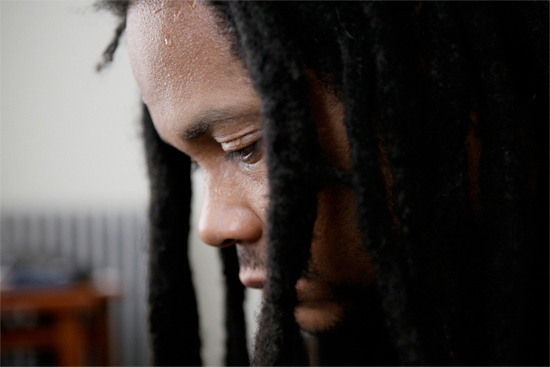
You wouldn’t necessarily look at those things and say ‘I aspire to be that’. Well, I suppose maybe some people do.
JM: Well, now they do, but back then… Yeah, when you living it, no. That’s what I mean. You were living the boys in the hood. So the fact is, you see a movie now or videos now, that kind of portray that image, that fantasy like it’s something exciting – no, when you live that, that ain’t exciting. It would not be real hard for a black kid in the city to want to go industrial or EBM or new wave, just so he wouldn’t catch a bullet, so somebody wouldn’t confuse him as being in a rival gang. Believe me, if a black kid was walking down the street looking like Robert Smith, and not looking like NWA, chances are he’s not gonna get shot. He might get made fun of, but he won’t get shot, because they probably won’t confuse him with being in a gang, you see what I’m saying?
The other thing I wanted to ask you about was your live performances and your DJing. I saw you DJ at CTM in Berlin earlier this year, and it really struck me how apart from the normal conventions of DJing it was. You didn’t seem scared to really confront people with quite aggressive shifts in tone and tempo, and noise, and all these ideas that generally aren’t accepted to be ok things to do to a club crowd, as a DJ. How did you come to this approach?
JM: Well, technically speaking, in Chicago, there’s two types of people when they DJ or be selectors. You can do the whole clean way, with the whole BPM and making it smooth, transitions or whatever – or you can do it my way. That’s been a style in Chicago for a long time. I’m not going to go into the whole Ron Hardy factor, the RH factor, whatever you call it, but technically speaking there are DJs in Chicago who basically follow that lineage of Ron Hardy – like, kind of putting a shock to the system when you’re being a DJ. So you’ve got to realise, you’re in an industry now where they expect every DJ who comes along to be clean, to be precise, to connect all the beats for long periods of time, you know what I’m saying? Eventually you can tell by looking at people they’re really bored by that.
So you have to do the opposite, and the opposite for me is what I already grew up with. That style is not something new, it’s something I’ve seen with my own eyes that Ron Hardy did, and a couple of other DJs. Gene Hunt I remember used to spin like that, I used to go to parties back in the day and see him play like that, and DJ Rush – I used to go to the Reactor, because him and Ron Trent used to do this club back in the day, they would play together back to back every weekend.
It’s rare to encounter that kind of style these days, at least in the UK. The accepted dogma is that your transitions have to be clean, have to be smooth, everything has to be perfect, so as not to jar people. Almost the exact opposite of maybe what you want to do, which is shake people up and make them confront where they are and what they’re doing.
JM: Exactly. It’s about letting them actually hear the music, and not about my vanity or how well I can paint or gel these pieces together. Not to diss other DJs who do that, but for me, to sit there and painstakingly make sure something blends together smoothly and transition properly, I’m like, man, how are people going to really identify what’s that sound, what song is that? Because each song has its own signature, its own harmonics, its own vibration, and if you’re sitting there dulling that sound when you’re blending that so smoothly, then you can’t properly transmit the energy that song is supposed to do. That’s how I see it.
Every song is like every individual. It’s like, if I’m walking down the street, the vibrational harmony someone would see that comes off of my presence would probably give a shock to someone, you see what I’m saying? And if somebody’s walking down the street looking like Obama, they would probably give a pleasant feel and smooth vibe to someone, because it’s more clean cut, more smooth, you see what I’m saying? So the same way you perceive people visually and physically in life is the same way you perceive music sonically, and how you feel to your body, harmonically and vibrationally.
So it’s about reflecting life.
JM: Exactly.
What you were saying before – it’s messy, it’s complicated, it’s not that smooth and simple.
JM: Yeah.
When it works, can you see the audience getting physically drawn into it?
JM: Well, if you hadn’t noticed, I don’t look up much…
Aha, yeah, that’s true, I did notice that.
JM: I try not to focus on worrying about what the people are feeling. I just try to put the feeling out there, and hope they can just grasp and celebrate, because it’s about coming there and celebrating life, or trying to get the stresses of life off your back for that night. So I try not to interject my ego into it, and just say, ‘Ok, even though you might have had a shitty week or a shitty night, I’m going to put my all-encompassing power and force energy upon you, and you’re going to bend to my will.’ It’s not supposed to be like that. People come to get that energy out and feel cleansed when they walk out of there. So I try not to look into the crowd, and think ‘Ok, somebody’s not moving, I must impose my will to make them move.’ Because I don’t know what is in their head at the time. There could be some girl sitting there pissed off because her man didn’t show up, pissed off because her man is making out with some chick in the corner! You see what I’m saying?
You’ve got to let go of that stuff, you know. You’ve just got to focus on the selection and play the music and hope it all falls into place and people have a good time. That’s why I don’t look up. Because I have a habit of being empathetic. I can look at people and start reading emotions off of them. And in turn if I do that, it might influence what I want to play. So I try to literally just keep my head down and focus on what I’m supposed to do, and just hope it pans out.
For more on Hieroglyphic Being and Mathematics you can head to the Mathematics website and Jamal Moss’ Soundcloud, which contains a selection of new demo tracks.
Hieroglyphic Being plays the following dates in the UK and Europe this month:
OCTOBER
6th – Tusk Festival, Newcastle
8th – Manchester, Gullivers
9th – Glasgow, Nice N Sleazy
10th – Rewired Live, Royal Albert Hall, London w/ Bass Clef, TVO
12th – Shacklewell Arms, London w/ Lee Gamble
13th – The Croft, Bristol w/ Mark Fell, Young Echo Collective
14th-21st – Unsound Festival, Krakow, Poland
Top & middle photos: Bryan Lear

